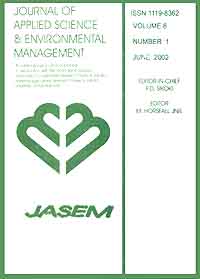
|
Journal of Applied Sciences and Environmental Management
World Bank assisted National Agricultural Research Project (NARP) - University of Port Harcourt
ISSN: 1119-8362
Vol. 22, No. 8, 2018, pp. 1171-1176
|
 Bioline Code: ja18198
Bioline Code: ja18198
Full paper language: English
Document type: Research Article
Document available free of charge
|
|
|
Journal of Applied Sciences and Environmental Management, Vol. 22, No. 8, 2018, pp. 1171-1176
| en |
Miospore Biozonation of Cenomanian - Santonian Succession in FAMO-1 well, Gongola Sub Basin, Upper Benue Trough, Nigeria
AMIEWALAN, FO & LUCAS, FA
Abstract
The Early Cretaceous succession penetrated by Famo-1 well in Gongola sub Basin, Upper Benue
Trough, Nigeria were analyzed for its palynological content. This investigation produced significant Pollen and Spore and
the assemblage reveals the dominance of angiosperm Pollen grain and pteridophytes spore. Gymnosperm pollen was
scarce and less varied. The studied interval penetrated a sequence of sandstone, sandy shale and mudstone occurring at
different intervals in the studied section of the well. Established on the stratigraphic distribution of the palynomorphs
recovered from Famo-1 well, three informal assemblage palynozones covering the Early Cretaceous were identified. The
zones are: Assemblage Zones I & II (Cenomanian); Assemblage Zone III (Turonian - Santonian). The different zones
signifies a time stratigraphic unit comparable to the identified lithostratigraphic units penetrated by the well. The age
(Cenomanian - Santonian) determinations are based on the known stratigraphic ranges of pollen and spores and their
relative stratigraphic positions. Data from the studied well revealed that there is relatively higher frequency of the land
derived pollen and spores compared to marine palynomorph abundance, which suggests a paralic condition of continental
to shallow marine environment. The shallow marginal marine environment is further sustained by the presence of
foraminifera test linings at some depths which are indicative of marine palaeoenvironment (inner neritic environment).
Interpretations from the spore and pollen assemblages reveal sediment deposition took place in a wet to arid climate
condition in marginal marine to nearshore environment.
Keywords
Palynology; Gongola sub Basin; Cretaceous; Famo-1 Well.
|
| |
© Copyright 2018 - Amiewalan and Lucas
|
|
